Even though the gravity from black holes is so strong that light can’t even escape, we can see the radiation from the superheated matter that’s about to be consumed. Until now, scientists haven’t been able to explain how all this matter continuously falls into the black hole – it should just orbit, like planets going around a star. New data from the Chandra X-Ray Observatory shows that a black hole’s powerful magnetic field creates a turbulence in surrounding matter that helps drive it inward to be consumed.
Continue reading “Magnetic Fields Help Black Holes Pull In Matter”
Everything’s on the Menu for Supermassive Black Holes
The supermassive black holes that lurk at the heart of most galaxies have enormous appetites. They’ve already consumed millions of times the mass of our own Sun, and they’re not done yet. Everything’s on the menu: mostly gas, dust, planets and stars, but the occasional exotic delicacy gets consumed too. “Compact objects”, such as stellar mass black holes, neutron stars, and white dwarfs occasionally fall into their grasp too. But these objects don’t go with a whimper; they make screams we’ll soon hear across intergalactic space.
Continue reading “Everything’s on the Menu for Supermassive Black Holes”
Podcast: Dark Energy Stars
Black holes… you know. Cosmic singularities that can contain the mass of billions of stars like our Sun. Where the pull of gravity is so strong, nothing, not even light can escape their fearsome grasp. They’re the source of much discussion, indirect observation and science fiction speculation. But according to George Chapline from Lawrence Livermore National Laboratory in California, they don’t exist. Instead we have dark energy stars, which are connected to that mysterious force accelerating the expansion of the Universe.
Continue reading “Podcast: Dark Energy Stars”
The Sky is Full of Black Holes
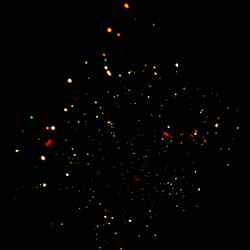
X-ray image of the Chandra Deep Field-North. Image credit: NASA/PSU Click to enlarge
Data from X-ray observatory surveys show that black holes are much more numerous and evolved differently than researchers would have expected, according to a Penn State astronomer.
“We wanted a census of all the black holes and we wanted to know what they are like,” said Niel Brandt, professor of astronomy and astrophysics. “We also wanted to measure how black holes have grown over the history of the Universe.”
Brandt and other researchers have done just that by looking at a patch of sky in the Northern hemisphere called the Chandra Deep Field-North, using NASA’s Chandra X-ray Observatory and a similar patch in the Southern hemisphere called the Extended Chandra Deep Field-South. Surveys also are being carried out in other parts of the sky using both Chandra and the European Space Agency’s X-ray Multi-Mirror Mission-Newton.
The researchers looked at X-ray emissions because areas around black holes emit X-rays as well as visible light. The penetrating nature of X-rays provides a direct way to identify the black holes. Using X-rays also enables astronomers to pinpoint the black holes at the centers of galaxies without their signal being washed out by the visible light coming from a galaxy’s stars, Brandt told attendees at the annual meeting of the American Association for the Advancement of Science in St. Louis, Mo. Feb. 17. The black holes they studied were those that reside at the centers of galaxies and are actively emitting X-rays, therefore they are called active galactic nuclei.
“We find active super massive black holes at the centers of massive galaxies,” said Brandt. “Our galaxy also has its own black hole at its center measuring 2.6 million solar masses. Our black hole is not active today, but we presume it was active in the past.”
These deep, extragalactic X-ray surveys looked at carefully chosen patches of sky, that are largely free of anything that might interfere with obtaining the X-ray data. Chandra looked at the Chandra Deep Field-North — an area of sky two thirds the size of the full Moon — for the time span of 23 days over a two-year period. The researchers detected about 600 X-ray sources. After comparing the X-ray images with optical images of exactly the same slice of sky taken by the Hubble Space Telescope, nearly all 600 point sources corresponded to optical galaxies, suggesting that the black holes that were sources for the X-ray signature were in the centers of galaxies.
“X-ray astronomers are doing better than anyone else by about a factor of ten, in identifying these active galactic nuclei” said Brandt. “With more time we could do even better, going even deeper.”
What the researchers found was that super massive black holes are more numerous than we might have expected. They also found that black holes evolved differently than astronomers expected prior to the Chandra work. Extrapolating from the 600 black holes found by Chandra, Brandt suggests that there are about 300 million super massive black holes in the whole sky.
The existence of so many black holes, confirmed that what was once thought to be a truly diffuse cosmic X-ray background radiation, actually comes from point sources.
In the 1960s, astronomers discovered quasars, very distant, highly luminous black holes, in galactic centers. Quasars, initially called quasi-stellar radio sources, were studied intensely. Researchers soon realized that only some of these objects were radio emitters and that they formed early in the history of the Universe.
“While quasars are spectacular, they are not representative of typical active galactic nuclei,” said Brandt. “Now, using Chandra and other X-ray observatories, we can find and study the moderate-luminosity, typical active galactic nuclei in the distant, high-redshift Universe.”
Quasars and moderate-luminosity active galactic nuclei also evolved differently. Quasars are a phenomenon of young galaxies, while moderate-luminosity, active galactic nuclei peaked later in cosmic time.
“We would like to know if active galactic nuclei change over cosmic time,” said Brandt. “Do black holes feed and grow in the same way over the history of the Universe?”
Researchers looked at the relative amount of power coming out in X-rays compared to other wavelengths and found that this ratio does not change over 13 billion years of time. They looked at the X-ray spectra and found that these also did not change through time.
“Despite the enormous changes in the space density of back holes, the individual engines powering active galactic nuclei are remarkably stable,” Brandt said.
Brandt believes that Chandra could observe the Chandra Deep Field-North for a longer period of time and obtain more sensitive, deeper data. This would bring to light galaxies that are currently obscured. It would also gather more X-rays allowing better X-ray spectral and variability analyses. With more sensitive probing, the researchers are also detecting an increasing number of non-active galaxies like our own.
“Chandra has worked well for six years now,” said Brandt. “There is no reason why Chandra and Newton cannot continue to observe for another 10 or more years.”
Original Source: PSU News Release
Black Hole Gulps Down a Neutron Star
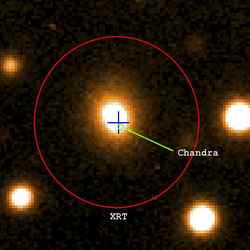
Gamma-Ray Burst GRB 050724. Image credit: ESO Click to enlarge
An international team of astronomers reports the discovery of a third short gamma-ray burst, associated with a nearby elliptical galaxy. The low level of star formation in such galaxies and the detection of a second long-lasting flare indicate that this gamma-ray burst is most likely the final scream of a neutron star as it is being devoured by a black hole.
Gamma-ray bursts (GRBs), the most powerful type of explosion known in the Universe, come in two different flavours, long and short ones. Over the past few years, international efforts have shown that long gamma-ray bursts are linked with the ultimate explosion of massive stars (hypernovae).
Very recently, the observations by different teams – including the GRACE and MISTICI collaborations that use ESO’s telescopes – of the afterglows of two short gamma-ray bursts provided the first conclusive evidence that this class of objects originates most likely from the collision of compact objects, neutron stars or black holes.
On July 24, 2005, the NASA/PPARC/ASI Swift satellite detected another short gamma-ray burst, GRB 050724. Subsequent observations, including some with the ESO Very Large Telescope, allowed astronomers to precisely pinpoint the position of the object, lying about 13,000 light-years away from the centre of an elliptical galaxy that is located 3,000 million light-years away (redshift 0.258).
“From its characteristics, we infer that this galaxy contains only very old stars,” says Guido Chincarini (INAF-Brera and Milan University, Italy), co-author of the paper presenting the results. “This is similar to the host galaxy of the previous short GRB which could be precisely localised, GRB 050509B, and very different from host galaxies of long bursts.”
These observations thereby confirm that the parent populations and consequently the mechanisms for short and long GRBs are different in significant ways. The most likely scenario for short GRBs is now the merger of two compact objects.
The observations also show this short burst has released between 100 and 1000 less energy than typical long GRBs. “The burst itself was followed after about 200-300 seconds by another, less-energetic flare,” says Sergio Campana (INAF-Brera), co-author of the paper. “It is unlikely that this can be produced by the merger of two neutron stars. We therefore conclude that the most probable scenario for the origin of this burst is the collision of a neutron star with a black hole.”
Original Source: ESO News Release
That Neutron Star Should Be a Black Hole
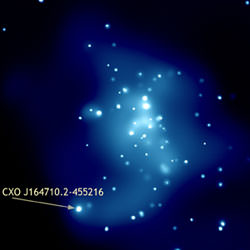
Westerlund 1 star cluster. Image credit: Chandra. Click to enlarge.
A very massive star collapsed to form a neutron star and not a black hole as expected, according to new results from NASA’s Chandra X-ray Observatory. This discovery shows that nature has a harder time making black holes than previously thought.
Scientists found this neutron star — a dense whirling ball of neutrons about 12 miles in diameter — in an extremely young star cluster. Astronomers were able to use well-determined properties of other stars in the cluster to deduce that the progenitor of this neutron star was at least 40 times the mass of the Sun.
“Our discovery shows that some of the most massive stars do not collapse to form black holes as predicted, but instead form neutron stars,” said Michael Muno, a UCLA postdoctoral Hubble Fellow and lead author of a paper to be published in The Astrophysical Journal Letters.
When very massive stars make neutron stars and not black holes, they will have a greater influence on the composition of future generations of stars. When the star collapses to form the neutron star, more than 95% of its mass, much of which is metal-rich material from its core, is returned to the space around it.
“This means that enormous amounts of heavy elements are put back into circulation and can form other stars and planets,” said J. Simon Clark of the Open University in the United Kingdom.
Astronomers do not completely understand how massive a star must be to form a black hole rather than a neutron star. The most reliable method for estimating the mass of the progenitor star is to show that the neutron star or black hole is a member of a cluster of stars, all of which are close to the same age.
Because more massive stars evolve faster than less massive ones, the mass of a star can be estimated from if its evolutionary stage is known. Neutron stars and black holes are the end stages in the evolution of a star, so their progenitors must have been among the most massive stars in the cluster.
Muno and colleagues discovered a pulsing neutron star in a cluster of stars known as Westerlund 1. This cluster contains a hundred thousand or more stars in a region only 30 light years across, which suggests that all the stars were born in a single episode of star formation. Based on optical properties such as brightness and color some of the normal stars in the cluster are known to have masses of about 40 suns. Since the progenitor of the neutron star has already exploded as a supernova, its mass must have been more than 40 solar masses.
Introductory astronomy courses sometimes teach that stars with more than 25 solar masses become black holes — a concept that until recently had no observational evidence to test it. However, some theories allow such massive stars to avoid becoming black holes. For example, theoretical calculations by Alexander Heger of the University of Chicago and colleagues indicate that extremely massive stars blow off mass so effectively during their lives that they leave neutron stars when they go supernovae. Assuming that the neutron star in Westerlund 1 is one of these, it raises the question of where the black holes observed in the Milky Way and other galaxies come from.
Other factors, such as the chemical composition of the star, how rapidly it is rotating, or the strength of its magnetic field might dictate whether a massive star leaves behind a neutron star or a black hole. The theory for stars of normal chemical composition leaves a small window of initial masses – between about 25 and somewhat less than 40 solar masses – for the formation of black holes from the evolution of single massive stars. The identification of additional neutron stars or the discovery of black holes in young star clusters should further constrain the masses and properties of neutron star and black hole progenitors.
The work described by Muno was based on two Chandra observations on May 22 and June 18, 2005. NASA’s Marshall Space Flight Center, Huntsville, Ala., manages the Chandra program for the agency’s Science Mission Directorate. The Smithsonian Astrophysical Observatory controls science and flight operations from the Chandra X-ray Center in Cambridge, Mass.
Additional information and images are available at: http://chandra.harvard.edu
and http://chandra.nasa.gov
Original Source: Chandra News Release
Rogue Supermassive Black Hole Has No Galaxy
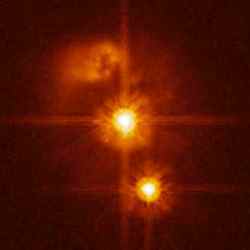
Hubble image from a sample of 20 nearby quasars. Image credit: NASA/ESA/ESO Click to enlarge
The detection of a super-massive black hole without a massive ‘host’ galaxy is the surprising result from a large Hubble and VLT study of quasars.
This is the first convincing discovery of such an object. One intriguing explanation is that the host galaxy may be made almost exclusively of ‘dark matter’.
A team of European astronomers has used two of the most powerful astronomical facilities available, the NASA/ESA Hubble Space Telescope and the ESO Very Large Telescope (VLT) at Cerro Paranal, to discover a bright quasar without a massive host galaxy.
Quasars are powerful and typically very distant source of huge amounts of radiation. They are commonly associated with galaxies containing an active central black hole.
The team conducted a detailed study of 20 relatively nearby quasars. For 19 of them, they found, as expected, that these super-massive black holes are surrounded by a host galaxy. But when they studied the bright quasar HE0450-2958, located some 5000 million light-years away, they could not find evidence for a host galaxy.
The astronomers suggest that this may indicate a rare case of a collision between a seemingly normal spiral galaxy and an ‘exotic’ object harbouring a very massive black hole.
With masses that are hundreds of millions times bigger than the Sun, super-massive black holes are commonly found in the centres of the most massive galaxies, including our own Milky Way. These black holes sometimes dramatically manifest themselves by devouring matter that they gravitationally swallow from their surroundings.
The best fed of these objects shine as ‘quasars’ (standing for ‘quasi-stellar object’ because they had initially been thought of as stars).
The past decade of observations, largely with the Hubble telescope, has shown that quasars are normally associated with massive host galaxies. However, observing the host galaxy of a quasar is challenging work because the quasar completely outshines the host and masks the galaxy?s underlying structure.
To overcome this problem, the astronomers devised a new and highly efficient strategy. Combining Hubble?s ultra-sharp images and spectroscopy from ESO?s VLT, they observed their sample of 20 quasars at the same time as a reference star. The star served as a reference pinpoint light source that was used to disentangle the quasar light from any possible light from an underlying galaxy.
Despite the innovative techniques used, no host galaxy was seen around HE0450-2958. This means that if any host galaxy exists, it must either be at least six times fainter than typical host galaxies, or have a radius smaller than about 300 light-years, i.e. 20 to 170 times smaller than typical host galaxies (which normally have radii ranging from about 6000 to 50 000 light-years).
“With the powerful combination of Hubble and the VLT we are confident that we would have been able to detect a normal host galaxy,” said Pierre Magain of the Universit? de Li?ge, Belgium.
The astronomers did however detect an interesting smaller cloud of gas about 2500 light-years wide near the quasar, which they call ‘the blob’. VLT observations show this cloud to be glowing because it is bathed in the intense radiation coming from the quasar, and not from stars inside the cloud. Most likely, it is the gas from this cloud that feeds the super-massive black hole, thereby allowing it to become a quasar.
“The absence of a massive host galaxy, combined with the existence of the blob and the star-forming galaxy, lead us to believe that we have uncovered a really exotic quasar,” said Fr?d?ric Courbin of the Ecole Polytechnique Federale de Lausanne, Switzerland.
“There is little doubt that an increase in the formation of stars in the companion galaxy and the quasar itself have been ignited by a collision that must have taken place about 100 million years ago. What happened to the putative quasar host remains unknown.”
HE0450-2958 is a challenging case. The astronomers propose several possible explanations. Has the host galaxy been completely disrupted as a result of the collision? Has an isolated black hole captured gas while crossing the disk of a spiral galaxy? This would require very special conditions and would probably not have caused such a tremendous disturbance of the neighbouring galaxy as is observed. Further studies will hopefully clarify the situation.
Another intriguing hypothesis is that the galaxy harbouring the black hole was almost exclusively made of ‘dark matter’. It may be that what is observed is a normal phase in the formation of a massive galaxy, which in this case has taken place several 1000 million years later than in most others.
Original Source: ESA Portal
The Birth of a New Black Hole?
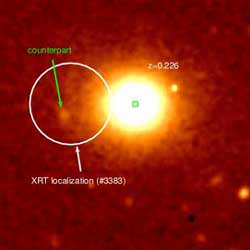
GRB 050509B, detected on 9 May 2005, was a *very* short burst, lasting just 30 milliseconds. Image credit: NASA/JPL. Click to enlarge.
After 30 years, they finally caught one. Scientists on Monday have for the first time detected and pinned down the location of a so-called “short” gamma-ray burst, lasting only 50 milliseconds.
The burst marks the birth of a black hole. The astronomy community is buzzing with speculation on what could have caused the burst, perhaps a collision of two older black holes or two neutron stars. A multitude of follow-up observations are planned; the answer might come in a few more days. “Everything about this gamma-ray burst so far supports the merger theory,” said Steinn Sigurdsson, associate professor of astronomy and astrophysics at Penn State and a gamma-ray-burst theorist.
Gamma-ray bursts are the most powerful explosions known in the universe. Recently, the longer ones — lasting more than two seconds — have become easy prey for NASA satellites such as Swift, built to detect and quickly locate the flashes. Short bursts had remained elusive until Monday, when Swift detected one, autonomously locked onto a location, and focused its onboard telescopes in less than a minute to capture the burst afterglow.
“Seeing the afterglow from a ‘short’ gamma-ray burst was a major goal for Swift, and we hit it just a few months after launch,” said Neil Gehrels, Swift project scientist at NASA Goddard Space Flight Center in Greenbelt, Maryland. “Now, for the first time, we have real data to figure out what these things are.”
Like clues left at a crime scene, the afterglow contains information about what caused the burst. Most scientists are convinced short and long bursts arise from two different catastrophic origins. The longer bursts appear to be from massive star explosions in very distant galaxies. The shorter ones — less than two seconds and often just a few milliseconds — are the deeper mystery because they have been simply too fast to observe in detail.
The Monday burst is called GRB 050509B. Swift’s X-ray Telescope detected a weak afterglow that faded away after about five minutes. Swift’s Ultraviolet/Optical Telescope did not see an afterglow. Ground-based telescopes have not yet definitely detected an afterglow either. In contrast, afterglows from long bursts linger from days to weeks.
All of this fits the pattern of a collision between some combination of black holes or neutron stars, both of which are created in the death of massive stars. Neutron stars are dense spheres about 20 miles across. Black holes have no surface and are regions in space of infinite density. Theory predicts that these kinds of collisions wouldn’t produce a long afterglow because there isn’t much “fuel” — such as dust and gas — from the objects and in the region to sustain an afterglow.
GRB 050509B appears to have occurred near an unusual galaxy that has old stars and is relatively nearby–about 2.7 billion light years away–which also is consistent with the theory that short bursts come from older, evolved neutron stars and black holes. In contrast, longer gamma-ray bursts tend to be in young, distant galaxies filled with young, massive stars — remnants of the early universe.
“We are combing the region around the burst with the Keck Telescope for clues about this burst or its host galaxy,” said Shri Kulkarni, a gamma-ray burst expert at Caltech. “What we are seeing so far is what proponents of the merger theory have been saying all along.” Such an evanescent afterglow has been expected in the most popular model for short hard bursts to date. Additional observations are planned for NASA’s Hubble Space Telescope and Chandra X-ray Observatory.
Swift is a NASA mission in partnership with the Italian Space Agency and the Particle Physics and Astronomy Research Council, United Kingdom; and is managed by NASA Goddard. Penn State controls science and flight operations from the Mission Operations Center in University Park, Pennsylvania. The spacecraft was built in collaboration with national laboratories, universities, and international partners, including Penn State University; Los Alamos National Laboratory in New Mexico; Sonoma State University in Rohnert Park, California; Mullard Space Science Laboratory in Dorking, Surrey, England; the University of Leicester in England; Brera Observatory in Milan, Italy; and ASI Science Data Center in Frascati, Italy. For more information about this and other Swift-detected bursts, refer to http://grb.sonoma.edu.
Original Source: Eberly College News Release
Matter is Incinerated When it Falls into a Black Hole
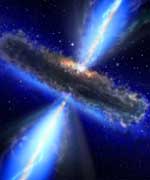
Image credit: ESA
Contrary to established scientific thinking, you’d be roasted and not “spaghettified” if you stumbled into a supermassive black hole. New research being presented at the Institute of Physics conference Physics 2005 in Warwick will take a new look at the diet of the universe’s most intriguing object, black holes.
Black holes stand at the very edge of scientific theory. Most scientists believe they exist, although many of their theories break down under the extreme conditions within. But Professor Andrew Hamilton of the University of Colorado says he knows what you would find inside, and challenges the traditional idea that gravity would cause you death by “spaghettification”.
Most people have heard of the event horizon of a black hole, as the point of no return. But astronomically realistic black holes are more complex and should have two horizons, an outer and an inner. In the bizarre physics of black holes, time and space are exchanged when you cross an event horizon, but at a second horizon they would switch back again.
Traveling into a black hole, you would therefore pass through a strange region where space is falling inward faster than light, before finally entering a zone of normal space at the core. It’s this core of normal space which Professor Hamilton has been working on.
A so-called singularity sits at the centre of the core, swallowing up matter. But according to Professor Hamilton, the strange laws of general relativity temper its appetite. If the singularity ate too quickly, it would become gravitationally repulsive, so instead, matter piles up in a hot, dense plasma filling the core of the black hole and siphoning gradually into the singularity.
Depending on the size of the black hole, this plasma could be the cause of a space traveller’s demise. Most books will tell you that under the extreme gravitational conditions of a black hole, your feet would experience gravity more strongly than your head, and your body would be stretched out like spaghetti.
For a small black hole with the mass of several suns, this should still be true. But for a supermassive black hole weighing millions or billions of suns, explains Professor Hamilton, the tidal forces which cause spaghettification are relatively weak. You would instead be roasted by the heat of the plasma.
Professor Andrew Hamilton is Professor of Astrophysics at the Department of Astrophysical and Planetary Sciences, University of Colorado.
Original Source: Institute of Physics News Release
Matter Nears Light Speed Entering a Black Hole
The whole sky is filled with a diffuse, high energy glow: the cosmic X-ray background. In the last years the astronomers could show, that this radiation can almost completely be associated with individual objects. Similarly, Galileo Galilei in the beginning of the 17th century resolved the light of the Milky Way into individual stars. The X-ray background originates in hundreds of millions of supermassive Black Holes, which feed from matter in the centres of distant galaxy systems. Because the Black Holes are accreting mass, we observe them in the X-ray background during their growth phase. In today’s Universe, massive Black Holes are found in the centres of practically all nearby galaxies.
When matter rushes down the abyss of a Black Hole, it speeds around the cosmic maelstrom almost with the velocity of light and is heated up so strongly, that it emits its “last cry of help” in the form of high energy radiation, before it vanishes forever. Therefore the putatively invisible Black Holes are among the most luminous objects in the universe, if they are fed well in the centres of so called active galaxies. The chemical cal elements in the matter emit X-rays of a characteristic wavelength and can therefore be identified through their spectral fingerprint. Atoms of the element iron are a particularly useful diagnostic tool, because this metal is most abundant in the cosmos and radiates most intensely at high temperatures.
In a way similar to the radar traps, with which the police identifies speeding cars, the relativistic speeds of iron atoms circling the Black Hole can be measured through a shift in wavelength of their light. Through a combination of the effects predicted by Einstein’s special and general theory of relativity, however, a characteristically broadened, asymmetric line profile, i.e. a smeared fingerprint is expected in the X-ray light of Black Holes. Special relativity postulates that moving clocks run slow, and general relativity predicts that clocks run slow in the vicinity of large masses. Both effects lead to a shift of the light emitted by iron atoms into the longer wavelength part of the electromagnetic spectrum. However, if we observe the matter circling in the so called “accretion disk” (Fig. 1) from the side, the light from atoms racing towards us appears shifted to shorter wavelengths and much brighter than that moving away from us. These effects of Relativity are stronger, the closer the matter reaches to the black hole. Because of the curved spacetime they are strongest in fast rotating Black Holes. In the past years, measurements of relativistic iron lines have been possible in a few nearby galaxies – for the first time in 1995 with the Japanese ASCA satellite.
Now the researchers around G?nther Hasinger of the Max-Planck-Institute for extraterrestrial Physics, jointly with the group of Xavier Barcons at the Spanish Instituto de F?sica de Cantabria in Santander and Andy Fabian at the Institute of Astronomy in Cambridge, UK have uncovered the relativistically smeared fingerprint of iron atoms in the average X-ray light of about 100 distant Black Holes of the X-ray background (Fig. 2). The astrophysicists utilized the X-ray observatory XMM-Newton of the European Space Agency ESA. They pointed the instrument to a field in the Big Dipper constellation for more than 500 hours and discovered several hundred weak X-ray sources.
Because of the expansion of the Universe the galaxies move away from us with a speed increasing with their distance and thus their spectral lines all appear at different wavelength; the astronomers had first to correct the X-ray light of all objects into the rest frame of the Milky Way. The necessary distance measurements for more than 100 objects were obtained with the American Keck-Telescope. After having co-added the light from all objects, the researchers were very surprised about the unexpectedly large signal and the characteristically broadened shape of the iron line.
From the strength of the signal they deduced the fraction of iron atoms in the accreted matter. Surprisingly, the chemical abundance of iron in the “nutrition” of these relatively young Black Holes is about three times higher than in our Solar system, which had been created significantly later. The centres of galaxies in the early Universe therefore must have had a particularly efficient method to produce iron, possibly because violent star forming activity “breeds” the chemical elements rather quickly in active galaxies. The width of the line indicated that the iron atoms must radiate rather close to the black hole, consistent with rapidly spinning Black Holes. This conclusion is also found indirectly by other groups, who compared the energy in the X-ray background with the total mass of “dormant” Black Holes in nearby galaxies.
Original Source: Max Planck Society News Release
Want to update your computer desktop background? Here are some black background pictures.
